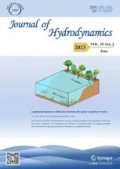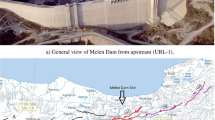Abstract
A new roller compacted concrete dam of Fengman Hydropower Station is to be built in the toe of the old dam, which was identified as a dangerous dam. The new dam during construction would be influenced by the high-speed flow discharged from the old dam, which is an important problem to be considered for the first time in China, and which would affect the construction of the whole project. Therefore, a series of erosion experiments were conducted in this article. A high-speed flow erosion test apparatus was developed for the erosion experiments of the new dam materials. The maximum jet velocity goes up to 40 m/s and the section area of the nozzle is 0.0025 m2. In the process of experiments, the equipment shows a good performance. Erosive wear tests for two types of materials used in the new dam, a roller compacted concrete and a distorted concrete with four kinds of ages were carried out with the flow velocity in the range of 30 m/s-35 m/s. Erosion parameters and erosion laws for the two types of concretes with different ages were determined, and a general relationship between the erosion rate and the flow velocity is obtained as: N = cv P, with the velocity exponent P between 3.33 and 3.93. It is concluded that the erosion resistance of the distorted concrete is better than that of the roller compacted concrete and the mechanical properties of the concretes of over 14 d age are influenced slightly by the water impact. The test results might serve as a practical technique guide for the safety of this project during its construction in the flood season.
Similar content being viewed by others
References
WU Jian-hua, LUO Chao. Effects of entrained air manner on cavitation damage[J]. Journal of Hydrodynamics, 2011, 23(3): 333–338.
STACHOWIAK G. W., BATCHELOR A. W. Engineering Tribology[M]. 3th Ed., London, UK: Elsevier, 2006, 501–551.
GE Yi-xiong, YANG Jing-jie and SUN Zhao-xiong. Preparation of abrasion resistance concrete with silica fume slag powder[J]. Journal of Wuhan University of Technology, 2009, 31(7): 68–71(in Chinese).
YIN Yan-guo, HU Xian-guo and CUI De-mi. Wear behaviors and mechanism of hydraulic concrete impacted by water jet with sand[J]. Journal of Hydroelectric Engineering, 2001, (4): 57–64(in Chinese).
LIU Juan, XU Hong-yuan and QI Long-hao et al. Erosive wear mechanism of metal materials used in hydraulic machines[J]. Tribology, 2005, 25(5): 470–474(in Chinese).
YE Jin-ming, XIONG Ying and LI Fang et al. Experimental study of effects of air content on cavitation and pressure fluctuations[J]. Journal of Hydrodynamics, 2010, 22(5): 634–638.
HU X. G., MOMBER A. W. and YIN Y. et al. Highspeed hydrodynamic wear of steel-fibre reinforced hydraulic concrete[J]. Wear, 2004, 257(5-6): 441–450.
HU X. G., MOMBER A. W. and YIN Y. Erosive wear of hydraulic concrete with low steel fiber content[J]. Journal of Hydraulic Engineering, 2006, 132(12): 1331–1340.
HORSZCZARUK E. Abrasion resistance of high-strength concrete in hydraulic structures[J]. Wear, 2005, 259(1-6): 62–69.
HORSZCZARUK E. Mathematical model of abrasive wear of high performance concrete[J]. Wear, 2008, 264(1-2): 113–118.
MOMBER A. W., KOVACEVIC R. Principles of abrasive water jet machining [M]. 1st Ed., London, UK: Springer, 1998.
GAO Xin-xin, CAI Yue-bo and DING Jian-tong. Influencing factors of abrasion of hydraulic concrete based on underwater method[J]. Journal of Hydraulic Engineering, 2011, 30(2): 67–71(in Chinese).
GUO Yuan-jun, PANG You-xia and WANG Yong-yan. On the abrasion performance of elastic coating material[ J]. Chinese Journal of Applied Mechanics, 2003, 20(4): 10–13(in Chinese).
LIU Guan-wei, WANG Shun-sen and MAO Jing-ru. Experimental investigation on solid particle erosion resistance of blade materials used in steam turbine[J]. Journal of Engineering Thermophysics, 2007, 28(4): 622–624(in Chinese).
GUO Yan-jun, YIN Jiong and HU Jian-xiong et al. Debacle and abrasion of on elastic coating of a hydraulic turbine[J]. Journal of Vibration and Shock, 2011, 30(2): 155–158(in Chinese).
MOMBER A. W. Damage to rocks and cementitious materials from solid impact[J]. Rock Mechanics Rock Engineering, 2004, 37(1): 57–82.
Author information
Authors and Affiliations
Corresponding author
Additional information
Project supported by the National Natural Science Foundation of China (Grant No. 51109143), the 11th Five Year Plan National Key Programs for Science and Technology Development of China (Grant No. 2009BAK56B04) and the Natural Science Foundation of Jiangsu Province (Grant No. BK2011109).
Biography: WANG Xin (1983- ), Male, Ph. D., Engineer
Rights and permissions
About this article
Cite this article
Wang, X., Luo, Sz., Hu, Ya. et al. High-Speed Flow Erosion on a New Roller Compacted Concrete Dam During Construction. J Hydrodyn 24, 32–38 (2012). https://doi.org/10.1016/S1001-6058(11)60216-3
Received:
Revised:
Published:
Issue Date:
DOI: https://doi.org/10.1016/S1001-6058(11)60216-3



